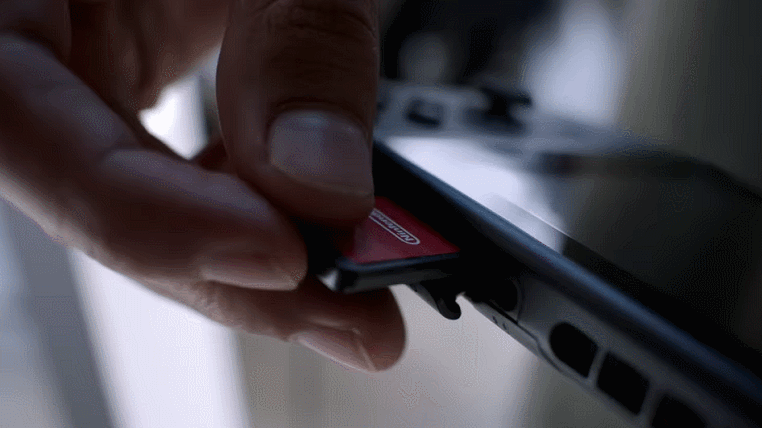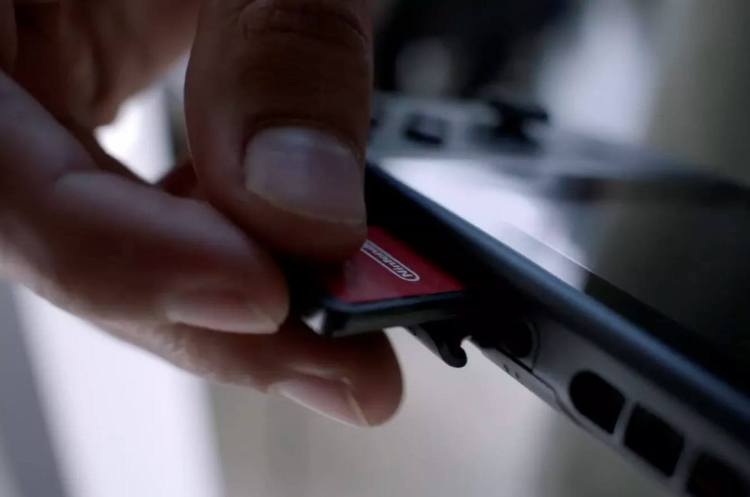Nintendo’s next gaming system will not use optical discs. Instead, the company is opting to fully embrace the technology it has used on its handhelds since the Nintendo DS.

Above: Putting a Game Card in the Switch.
Switch, the home/handheld hybrid Nintendo system that is due out in March, will use a new version of the company’s Game Cards to store software. After using discs for the GameCube, Wii, and Wii U, Nintendo is going back to cartridge-style solution that it used on its NES, SNES, and N64 systems. And while that might make many of you think of how third-party publisher despised working with carts on the Nintendo 64 back in the 1990s because they were more limited and expensive than the PlayStation’s CDs, the Game Cards that the Switch is using won’t have the same weaknesses.
Nintendo and its partners are not sharing details about the Switch and its various components. We likely won’t get answers to a lot of our lingering questions for months. I asked Nitnendo to comment on the tech behind its physical media for the Switch, but it has not provided a response to that request. But despite the silence from Nintendo, we can still piece together a lot about how the new console will work.
For years, Nintendo has used Mask ROM chips in the Game Cards for its handheld systems. This is a type of read-only memory circuit where parts of the chip are masked off during fabrication. The 3DS uses this storage solution. Taiwanese manufacturer Macronix provides Nintendo with the ROM chips that go into the 3DS Game Cards, and they have a storage limit of 8GB. For the 3DS handheld, that is more than enough space. Heck, 8GB is more than enough space for most first-party Nintendo Wii U games. Mario Kart 8, for example, was only around 5GB.
Mask ROM is more expensive to produce than a Blu-ray disc, but the cost difference is negligible. To press a Blu-ray disc, it costs about $2. An MROM cart can cost around $2.50 depending on fluctuations in metal-commodity markets. Additionally, the cartridges can include some rewriteable space so that consumers do not need to purchase a separate memory card and the system doesn’t need to reserve space on its hard drive for saves.
Macronix has already confirmed that it is working with Nintendo again on the Switch. The company hasn’t explicitly said it is providing the storage for the physical media. Macronix makes other products that could go into the Switch, but its financial outlook suggests that it is expecting to see a significant boost in revenue when the console launches as opposed to when it goes into production. And that suggests it is expecting to make its money closer to when the games start going on sale.
Now, 8GB is a lot of storage for a system like the 3DS, and it’s likely enough for most Nintendo games. But in the debut trailer for the Switch, Nintendo showed off huge third-party games like The Elder Scrolls V: Skyrim and NBA 2K17. Those games are around 30GB in size or more. And it’s unlikely that Nintendo would get as much third-party support as it has already attracted if it were going to require companies to chop their games in half to fit on the Switch. That suggests that the new Nintendo system is likely using the latest Mask ROM chips that can hold up to 32GB. That’s still not enough for many games, but it’s possible that a Switch Game Card has enough real estate to include two 32GB-sized Mask ROM chips. That would increase the production cost, but it’s likely that only the most high-end blockbusters would need that much space. And it’s also likely that the Switch will sell more digital games than the Wii U ever did, and that would reduce the overall production cost for a company like Bethesda or 2K.
Finally, cartridges have one more obvious benefit over optical discs, and it’s the same reason no Nintendo handheld has ever used that tech: battery life. A spinning motor would squeeze the juice out of a portable system much faster than a bright screen or powerful graphics chip. Humans just haven’t figured out a lot of ways to increase the efficiency of that mechanical action. That means that discs on a handheld are a terrible idea — just ask the PlayStation Portable — and it makes it worth it to figure out how to make cartridges work instead.
VentureBeat's mission is to be a digital town square for technical decision-makers to gain knowledge about transformative enterprise technology and transact. Learn More

